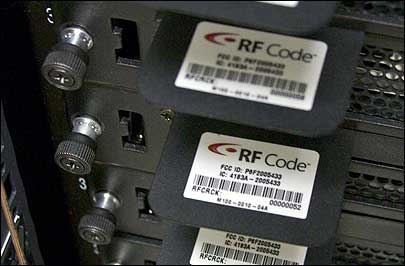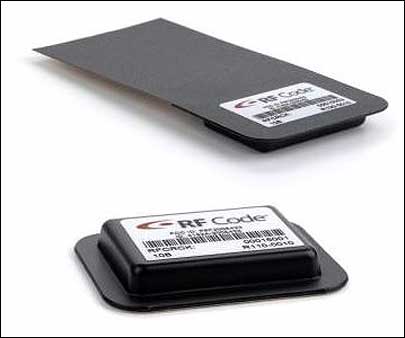Jan 29, 2008Data is gold, so tracking the IT assets that house data is a vital task for any enterprise. RF Code, an active RFID hardware and systems provider based in Austin, Texas, has rolled out a solution designed to enable companies to verify the location of such assets—even those that are not supposed to be mobile, such as rack-mounted servers.
Mitch Medford, who joined RF Code as CEO in 2007, says the company sees a tremendous market in tracking IT assets. According to Medford, active tags are more reliable, compared with passive tags and interrogators, and offer the ability to call up inventory updates in real time.
RF Code's IT asset-tracking system has three main components: 433 MHz RFID active tags, designed specifically for IT assets; a reader and antenna system that fits into a server rack, to read tags attached to any IT assets installed in that rack; and a middleware layer called Zone Manager, where duplicate tag reads are filtered and business rules are applied before the data is sent to higher-level asset inventory software.
The asset tags come in two form factors. One, designed for servers installed in a rack, has an adhesive strip of plastic that attaches to the top of a server. The active tag juts out, putting it within the range of the reader antennas that run vertically along the rack, one on each side. The tags and interrogator are tuned to minimize each tag's range, to decrease the likelihood that the interrogator will pick up signals from tags on servers in adjacent racks. The Zone Manager software then uses algorithms that analyze each tag's signal strength, to determine in which slot the server is placed within therack. This, Medford says, allows for precise determination of each server's location.
The second tag form factor can be attached to IT assets not placed inside server racks, such as laptop or desktop computers. It can be attached either via an adhesive backing, or through a zip tie.
Lavender says Cognizant has also installed RF Code's rack-mounted reader and specialized IT asset tags in 42 server racks inside its Calcutta data center, along with the RF Code Zone Manager middleware. The firm uses its own integration software to pull the inventory data into its Oracle database used to track capital assets (as well as to generate reports for Sarbanes-Oxley compliance).
Cognizant is acting as a partner to RF Code, offering its IT integration services to companies that want to deploy the RF Code hardware and middleware to track IT assets, but that require a third party to integrate the tracking and inventory data with whatever back-end reporting system the company is already using. Aside from integration into Oracle databases, Lavender says, Cognizant can also link the RFID data into Microsoft's BizTalk and many other enterprise software platforms.
The new IT offering reflects a new focus for RF Code, Lavender says. Founded in 1987, the company has developed active RFID asset tracking solutions for the health-care, pharmaceutical, retail, construction and industrial manufacturing markets.
The rack-mounted RF Code reader costs $995, Medford says, with the asset tags priced at $18.50 each. He notes that a large organization with a data center that houses 250 racks, with 30 IT assets to be tagged within each rack, can expect to spend $412,000 on hardware and software costs. That, he says, breaks down to $1,648 per rack, and $54.93 per device. But with IT assets replaced only once every three years, the monthly cost would be $1.53 per rack-mounted asset, spread over those three years.
Last week, Asure Software announced that its NetSimplicity division is now offering RF Code's IT asset-tracking hardware and middleware as part of its Visual Asset Management (VAM) product. VAM is a graphical software system designed to enable companies to track and monitor valuable assets.



